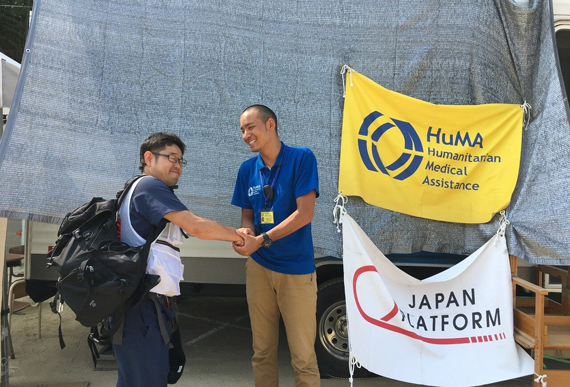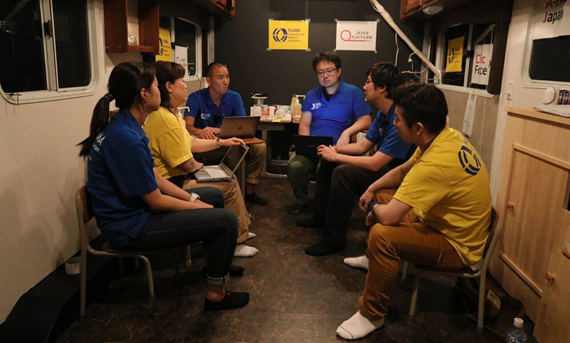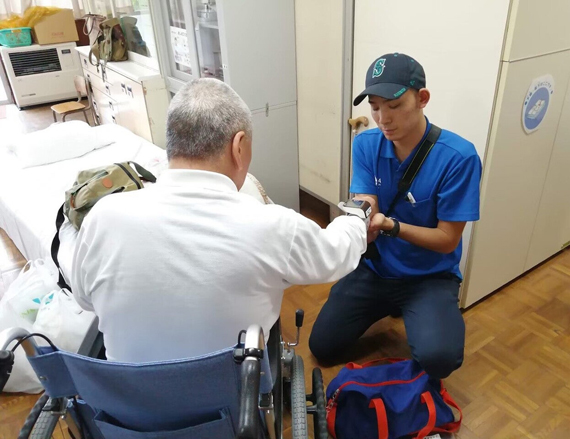| Shinnosuke Kitano (Graduate School of Medical and Health Science, Nippon Sports Science University/ Department of Emergency and Critical Care Medicine, Nippon Medical School Tama Nagayama Hospital) Interview that focusing on people participating in HuMA activities. The 4th interview is about Shinnosuke Kitano, a paramedic who had Doctoral Program in Emergency and Disaster Medicine in Graduate School of Medical and Health Science, Nippon Sports Science University. Furthermore, while he accumulates his clinical experiences in Department of Emergency and Critical Care Medicine, Nippon Medical School Tama Nagayama Hospital, he also devotes himself to disaster medical assistance. Let’s hear the thought of Mr. Kitano who is expected to be the leader of next generation in HuMA.  “Paramedics are all-rounders,”said Mr. Kitano (right) “Paramedics are all-rounders,”said Mr. Kitano (right) Aiming for becoming a paramedic with high specialty The desire of pursuing a job which can save people has rooted in my mind since high school. Although I can barely remember, I had Kawasaki disease at 1 year old and had major injury at 2 years old. After I heard this from my family, I began to think, “I have lived until today because of others’ help. From now on, I want to help others in return.” When I was deciding my path after high school, it occurred to me that Nippon Sport Science University was just going to set up a specialized course for Emergency and Critical Care. In the past, it was more prevalent to attend vocational school to become a paramedic. However, at that time, as the demand for emergency medical service had increased with aging society, paramedics which have more academic background would be needed. I believed this path should be able to make me get close to my goal of “pursuing a job which can save people.” In addition, I was attracted by the newly set-up course, so I decided to enroll in Department of Emergency Medical Science, Faculty of Medical Science, Nippon Sport Science University. In the autumn of my first year in university, I volunteered for the medical care of a marathon for the first time. My responsibility as a medical staff was to bring injured people to the medical room and provide emergency medical care support. With people having seizures or vomiting, the tough situation spreading in front of me was beyond my imagination. I remember that while I was shocked that I stood frozen on the spot even though I was learning about emergency medical care, I was assured that, “If I can deal with situations like this, I will be able to help people. This is what I am aiming for.” After that, I not only took courses in university, but attempted to attend a few more extracurricular activities and founded an emergency medical club with my friends. Moreover, I continued to attend cardiopulmonary resuscitation workshops and volunteer to provide medical assistance for sports events. I also made a presentation in an academic conference. Around that time, I found out about HuMA. As a doctor who is a member of HuMA helped me attend some event, it was natural for me to join HuMA’s activities after I qualified as a paramedic. Difficulties and responsibilities that he feels every time he works on site I have mainly played a role of the “logistician” in the previous disaster medical assistance. In a word, it is to establish an environment for a medical team to engage in activities. This job is generally called “logistics” that covers all but medical care by doctors or nurses: arranging activity locations; managing and replenishing equipment; securing a means of transportation and communication; and even publicizing the activities, among others. Having said that, we, HuMA, don’t have a complete division of labor between doctors or nurses and logisticians, and instead, we complement each other to run the team. Each of us tries to take the initiative in making conscious effort regardless of the boundaries. I consider that such a way is HuMA’s uniquely good point aligned with HuMA’s principle “delivering necessary support to those who need.” Doing our best as a team leads to making myself feel very rewarded. Information acquisition is particularly significant in fulfilling a role as a logistician. We make a plan and engage in activities based on information such as operating status of medical institutions around disaster-hit areas and availability of medical prescription on top of a damage situation and the number of affected people. It is challenging to grasp an entire picture of the damage in disaster sites, and the situation changes every moment. We have to assess what information has high reliability and what doesn’t in order to make a decision as a team. Every time I work on site, I feel the difficulties and responsibilities.  Team meeting after nighttime medical service Team meeting after nighttime medical service This year marks the fourth year since I became a paramedic. I participated in activities from the first year in HuMA, and in the next year and beyond, I joined an advance team as its member and was assigned to be a leader of a team that provide on-site staff with remote support. These engagements brought me invaluable experiences. Behind the scenes, by contrast, I was actually obsessed by misgivings such as “To what extent can we help people in the affected area?” and “Aren’t we ending up being a burden for the area?” In 2019, I joined Typhoon Hagibis relief activities in Nagano Prefecture. We arrived there the day after the disaster struck the area, returned to Tokyo, and then went to Nagano again. At that time, local nurses remembered us, and this experience made me think, “What we have done was not wrong.” I feel truly blessed as I am working with highly experienced senior members and taking on many tasks thanks to them. To meet their expectation, I hope to enhance my expertise and make the most of it for those who need support. |
 |
| Providing chronic phase medical treatment a few months after the disaster – assistance activities continued as long as there are people who need medical care |
By Yuki Domoto
Translation by Mariko Hirata and Yuheng Yu
(PR volunteers)


